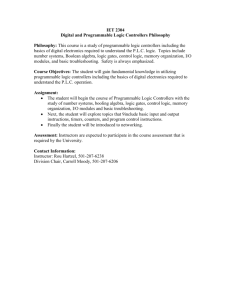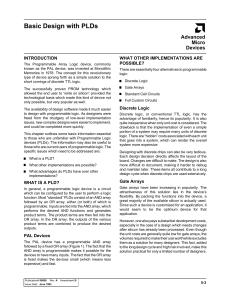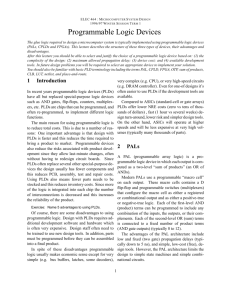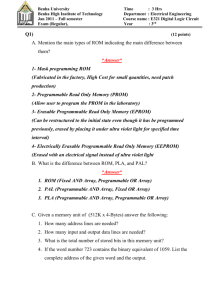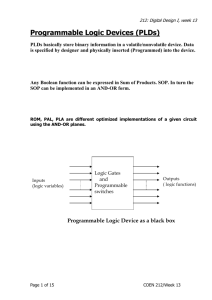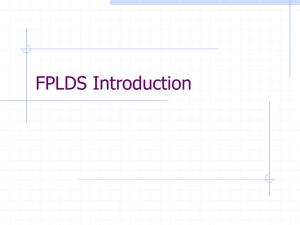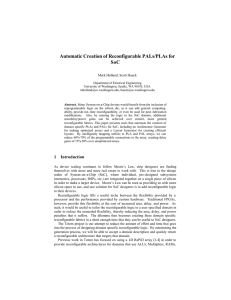PLDs
advertisement
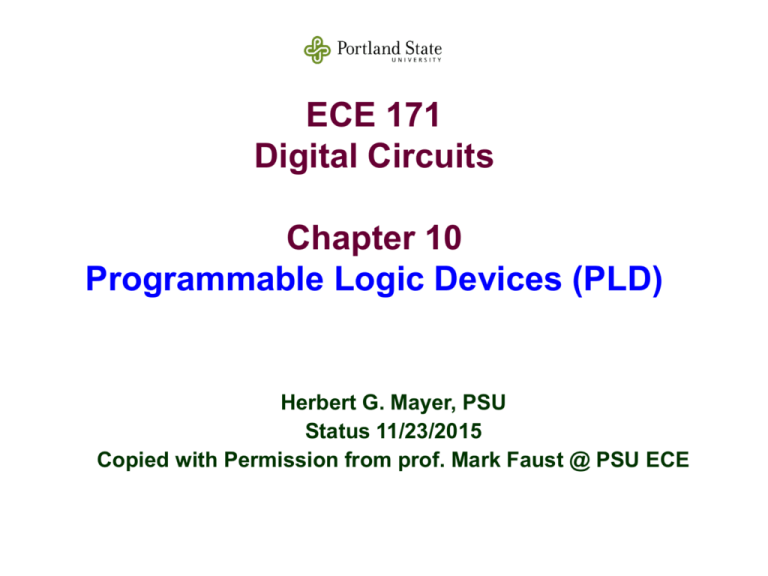
ECE 171 Digital Circuits Chapter 10 Programmable Logic Devices (PLD) Herbert G. Mayer, PSU Status 11/23/2015 Copied with Permission from prof. Mark Faust @ PSU ECE Syllabus Taxonomies of ICs PLDs Fuses PLD Implementation PROMs PLAs PALs GALs References Lecture 10 • Topics – Programmable Logic Devices (PLDs) • PROMs • PLAs • PALs and GALs – Positive and Mixed Logic 3 Taxonomies of ICs • Design Methodology – Standard Components (SSI/MSI/LSI) • Off-the-shelf Components • Basic Universal Building Blocks (AND, OR, NAND, NOR…) – Application-Specific Standard Parts (ASSP) • Target Specific Application Area, but not Customer • e.g. Printer Controller, USB Interface IC, HDD I/F – Application-Specific IC (ASIC) • Custom Design of IC Targeting Specific Market • Full-custom, standard cell, gate-arrays • e.g. ATI 3D Graphics Engine – Programmable Logic Devices (PLD) • Can be used to implement wide variety designs • e.g. FPGA (Field-Programmable Gate Arrays) 4 PLDs • Programmable Logic Devices (PLDs) • PROM: Programmable Read Only Memories (1960s) • PLA: Programmable Logic Arrays [Signetics] (1975) • PAL: Programmable Array Logic [MMI] (1976) • GAL: Generic Array Logic • CPLDs (Complex PLDs) • FPGA: Field Programmable Gate Arrays PAL and GAL are registered trademarks of Lattice Logic 5 AND/OR Array Architecture Device type PROM PLA PAL/GAL AND array Fixed at factory Programmable Programmable OR array Product term sharing Programmable Yes Programmable Yes Fixed at factory No 6 Programmable Symbology 7 “Fuses” • Actual fuses, transistor circuits, SRAM-based • Volatile and nonvolatile • Nonvolatile – UV (ultra-violet erasable) – EE (electrically erasable) • Universal Programming Unit • Fuse map – JEDEC standard format – Several programs generate (MACHXL, ABEL, CUPL) 8 PLD Implementation Schematic Capture • • • • Design Tools HDL PROM PLA PAL/GAL CPLDs Fuse Map Universal Programmer Tool and PLD vendors: Xilinx, Altera, Lattice 9 PROMs Product term sharing 10 PLAs Product term sharing 11 PALs/GALs No product term sharing 12 PAL with function sharing or additional inputs 13 Advantages to PLDs • Shorten design time – Rapid prototyping! • Rapid design changes – Reprogrammable • No masks, jumpers, PCB traces • Decrease PCB “real estate” – Less space than multiple standard logic packages • Improve reliability – Fewer packages, fewer external interconnects 14 PALxxyyzz Nomenclature xx zz y Maximum number of AND array inputs Maximum number of dedicated outputs Type of outputs Combinational H active high L active low P programmable C complementary Registered R registered RP registered, with programmable polarity Versatile V programmable as combinational or registered 15 Nomenclature Examples PAL3H2 3 inputs 2 outputs Active H outputs PAL16L8 16 inputs 8 outputs Active L (0s of function) PAL22V10 22 inputs 10 outputs Active L or H (1s or 0s) Registered if desired 16 PAL 17 GAL Emulate any PAL Reprogrammable Fuses are non-volatile memory cells 18 CPLDs – Complex PLDs 19 Designing with PROMs A 0 0 0 0 1 1 1 1 B 0 0 1 1 0 0 1 1 C 0 1 0 1 0 1 0 1 F 0 0 1 0 0 0 1 1 F C B A Address 00000 00001 00010 00011 00100 00101 00110 00111 Data 0XXXXXXX 0XXXXXXX 1XXXXXXX 0XXXXXXX 0XXXXXXX 0XXXXXXX 1XXXXXXX 1XXXXXXX 20 Example Implement: an inverter (NOT) an OR gate a NAND gate an XOR gate With: a PROM a PLA a PAL A 0 0 1 1 B 0 1 0 1 F1 1 1 0 0 F2 0 1 1 1 F3 1 1 1 0 F4 0 1 1 0 21 PROM Implementation NOT, OR, NAND, XOR A 0 0 1 1 B 0 1 0 1 F1 1 1 0 0 F2 0 1 1 1 F3 1 1 1 0 Fuse map Address Data 0 A 1 F 2 7 3 4 F4 0 1 1 0 22 PLA Implementation NOT, OR, NAND, XOR A 0 0 1 1 B 0 1 0 1 F1 1 1 0 0 F2 0 1 1 1 F3 1 1 1 0 F4 0 1 1 0 23 PLA Implementation NOT, OR, NAND, XOR A 0 0 1 1 B 0 1 0 1 F1 1 1 0 0 F2 0 1 1 1 F3 1 1 1 0 F4 0 1 1 0 24 PAL Implementation NOT, OR, NAND, XOR A 0 0 1 1 B 0 1 0 1 F1 1 1 0 0 F2 0 1 1 1 F3 1 1 1 0 F4 0 1 1 0 25 Logic Conventions • Positive Logic Convention (PLC) – Signals always “active high” (“asserted high”) – Bubble or negation indicator to show complementation • Direct Polarity Indication (DPI) – “mixed logic” notation – Suffix (H) or (L) indicates active high or active low – Polarity indicator or wedge to indicate active low PLC Signal Name DPI Signal Name Type of Signal A or A(H) B or B(H) A(H) or A(L) B(H) or B(L) Active High Active Low 26 Indicator Matching 27 Detailed DPI Example 28 29 Databook Examples 30
